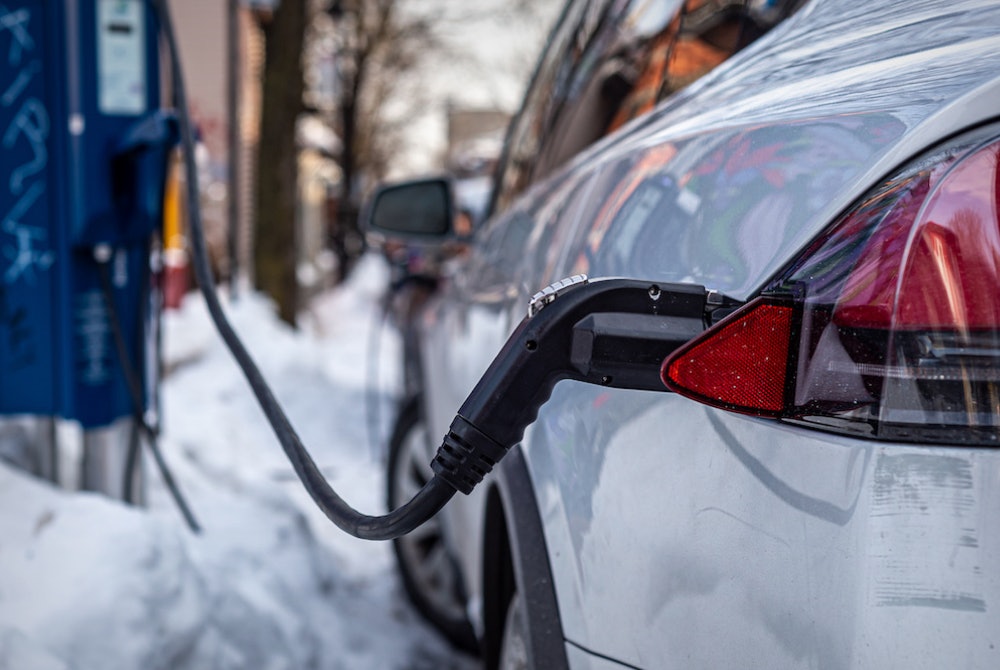- How Does Cold Weather Affect EV Battery Range?
- Do Certain Models Have Better Range in Cold Temps?
- How to Get the Best Range in Winter Weather
- Will My EV Stop Suddenly?
When it comes to cold weather, all electric vehicles experience some range loss, especially when the temperature drops below 20°F. According to AAA, when your car’s HVAC system is used to heat the inside of the car, you’ll likely see a range decrease by around 41%. Here’s why this occurs and what you can do to increase battery range in winter weather.
How Does Cold Weather Affect EV Battery Range?
A study by AAA found that for 100 miles of combined urban/highway driving at 20 degrees F, an EV’s driving range would be reduced to 59 miles (or by 41%). Yet another study by the Norwegian Automobile Federation found that colder temps reduced driving range by 20%.
While the exact percentage depends on a few factors, including the model you have, during the winter months, you can expect to charge more often to minimize the chance of being stranded by a dead battery.
The main reason this occurs is because cold temperatures slow down the chemical reactions in battery cells. Since EVs don’t have heat-producing engines, it leaves them having to use additional battery power to warm their cabins.
Additionally, cold weather affects how fast your car will charge. The batteries within electric vehicles like to be within a certain temperature range, so when it’s really cold out, it takes your battery longer to warm up before its able to charge at optimum speeds.
Do Certain Models Have Better Range in Cold Temps?
Yes, there are certain models that are able to retain some of their driving range in cold weather. Some EVs come with heat pumps which can warm the interior of the car without having to rely as heavily on its battery pack.
Vehicles such as the Audi E-Tron and Jaguar I-Pace, both heat-pump-equipped, generally retained a higher percentage of their EPA-rated range, recurrent data suggests.
"There could be a few reasons why EVs by Audi and Jaguar appear to outperform the others, but it certainly helps that both have heat pumps. Compared to resistive heating, heat pumps reduce winter range loss," says Jon Witt, battery and data scientist at Recurrent. "Importantly, Recurrent's winter range data is based on the car maker’s proprietary onboard range calculations. Another factor could be that Audi and Jaguar range calculations are less sensitive to temperature swings than other brands."
On the other hand, some EVs have active thermal management systems which can drain power since they are used to keep a battery pack warm during cold weather. For these vehicles, keeping your car plugged in during both cold and hot extremes can preserve driving range.

How to Get the Best Range in Winter Weather
To preserve as much range as possible in winter weather or colder climates, use these methods to avoid getting into sticky situations:
Park in Your Garage
If possible, keep your car parked in a garage or choose parking structures when not at home. Having your car indoors will help it hold a battery charge longer since it takes less energy to maintain a temperature than to raise it.
Warm-Up Your Car First
Before heading out, heat up your car in advance. Most EVs come with apps that allow drivers to turn on their car’s heating system from their devices.
Warming up the cabin in turn warms the battery and can improve its overall performance in the cold. Plus, if you keep your car plugged in while heating it, it won’t affect your battery’s charge.
Charge Ahead of Time
Plan ahead and set your charge to finish as close as possible to when you need to leave. Additionally, when it’s really cold out, your car’s battery management system will reserve around 15-20% capacity to heat the battery up. Try to keep its battery over 20% during low temps to minimize battery degradation.
Turn On Heated Seats
Using your heating system to keep you warm in freezing temperatures probably seems like a no-brainer. However, if you can avoid any wasted energy, the longer your range will be. When possible, use your car’s heated seats and/or steering wheel to consume less electricity and keep you warm.
Use Eco Mode
Most EVs come with eco mode which boosts mileage through reduced power consumption. This occurs by restricting the energy supply to the cabin heaters and driving motor, maximizing the battery’s efficiency during cold weather.
Plus, most electric vehicles accelerate slightly slower in eco mode, since power is reduced to the motor. This can make your driving safer by limiting the chances of wheel spins on snowy or icy roads.
Keep Your Tires Inflated
The air in your tires contracts when the temperature drops, and their air pressure begins to become affected. Tire pressure is decreased by one pound per square inch (PSI) every 10-degree drop in air temperature. One study showed that having the right pressure can increase your car’s energy efficiency by 3% to 7%.
So make sure you’re regularly checking your tires’ pressure to maximize winter range. Changing your everyday tires to winter ones are also a good option if you live in a snowy climate.
Drive Slower
Typically, in cold weather, motorists are driving more slowly. This is actually helpful in increasing range since speed drains the battery faster. Plus, with icy conditions on the roads, it’s likely much safer for you and your passengers to avoid any accidents.
Minimize Regenerative Braking
Some EVs allow you to adjust the regenerative braking feature, giving you the ability to engage your brakes more than in more moderate conditions.
"Regenerative braking sends energy back to the battery, recharging it when you brake. Sending high voltage charge to a cold battery could cause damage, so the car's computer systems limit regenerative braking until the battery warms up," says Witt. "To maximize the regenerative recharge and get the most range in cold weather, preconditioning your car will also help."
If your car has this feature, turn up your regenerative braking to send more power back to the battery.
Will My EV Stop Suddenly?
Don’t worry, your electric vehicle won’t suddenly shut down when it runs out of battery. Your car will give you plenty of warnings before this happens, with some automatically turning off heating systems to prolong battery life.
Tests show that most EVs will drive normally until the last few kilometers when a loss of acceleration and a limit on maximum speed occur—this is your final warning. If this does happen, however, and you’re left stranded, let the car sit for about 30-60 minutes.
Normally, you’ll get back enough power to drive a few more kilometers to either a safer stopping place or get to a charging station.


Comments